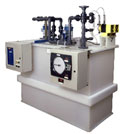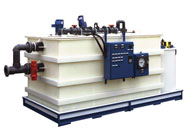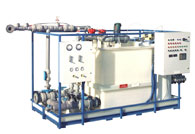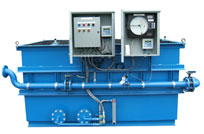Hydrofluoric (HF) Acid Neutralization
Hydrofluoric Acid is very widely used in
industry and is a precursor to many chemicals and materials and is widely used in pharmaceuticals, exotic
materials such as fluoropolymers, to etch glass, and to pickle metals
such as stainless steel. In the semiconductor industry HF is used to
etch silicon substrates.
Hydrofluoric acid is colorless and very
aggressive with the ability to dissolve many materials including
glass. HF also presents some very serious environmental health and
safety issues, unlike many acids an HF burn is usually innocuous,
doing little obvious damage at first, but can quickly lead to the
destruction of underlying tissues including bone. With a high
infinity for calcium (Ca) HF can lead to death by interfering with the metabolism and levels of Ca in the blood stream.
HF along with its sibling compounds, buffered oxide etch or Ammonium bifluoride (NH4HF2), must be neutralized before discharge.
Fluoride bearing wastewaters often need more than pH neutralization in that there are widely imposed fluoride limits throughout
the world requiring
fluoride reduction systems to reduce fluorides in industrial effluents.
Hydrofluoric Acid ( HF )
Hydrofluoric Acid HF:
With a pKa of 3.15 HF is considered a weak acid in that it is not full disassociated below a pH of about 5.5 and will form complexes with many compounds including itself.
Do not let the classification as a weak acid fool you, HF is a very aggressive
and dangerous acid. HF is commercially available in concentrations
ranging from 10% to 49% with 49% HF being the most common. The pH neutralization of hydrofluoric acid is
conventional and any inorganic base such as sodium hydroxide or lime
can be used.
Hydrofluoric acid is a one normal solution which means that for each mole of
HF one mole of H+ or acid is liberated requiring one mole of
hydroxide (OH-) to neutralize.
One mole of
sodium hydroxide (NaOH) is required to neutralize one mole of HF , as follows:
NaOH + HF → NaF + H20
Conversely one mole of lime as Ca(OH)2 will neutralize two moles of HF which is a common reaction in industrial fluoride reduction for the precipitation of fluorides as a relatively insoluble CaF2 salt:
Ca(OH)2 + 2HF → CaF2 + 2H20
Heat of Neutralization
All pH neutralization reactions are exothermic and heat will be released. In most practical applications the acid concentration is too low for the temperature rise to be a concern, however, as the concentration of acid increases above about 1% the temperature rise is not only measureable but can be of concern.
ΔHN = 55.83 KJ / Mole of H+
For example, neutralizing a 10% solution of HF acid will yield a temperature rise of nearly 300C while neutralizing a 49% solution of concentrated hydrofluoric acid will yield a temperature rise of over 1500C. This is enough to meltdown any thermoplastic piping system and hot enough to cause steam explosions.
Our concentrated acid pH neutralization systems take into account the known temperature rise and measures are taken to control this by continuous temperature monitoring, reaction rate control and, when required, the addition of quench water. An example of a concentrated acid pH neutralization system can be seen at: Battery Acid Neutralization
Precipitation Products
The pH neutralization of any strong acid with a strong base will produce a salt. When one of the reactants is relatively dilute the products of
neutralization will remain soluble, particularly if sodium (Na) is the cation. However, if the cation is calcium (Ca) or if the concentration of both reactants is
elevated then precipitation products (insoluble salts) will begin to form. In some cases these can simply be discharged to the drain, in others they may need to be removed
for any number of reasons particularly if high fluorides are present.
Whenever precipitation products are formed they can also become a maintenance headache.
In the example given above where
hydrofluoric acid is neutralized using lime the byproduct will be
calcium fluoride (CaF2). Calcium fluoride will form a
hard glass like crystalline coating on pipe, valves, and fittings
which is resistant to acid cleaning.
Digital Analysis Corp. manufactures a complete line of pH neutralization systems for the neutralization of
hydrofluoric acid (HF) and all mineral acids, bases, organic acids, and alkalis.
Three of our four families of effluent pH neutralization systems are
well suited for the neutralization of HF bearing effluent wastewater
and these include our pHASE,
labTREAT, and
batchTREAT families of pH
neutralization systems.
Packaged / Skid Mounted pH Neutralization Systems
Digital Analysis manufactures four families of pH adjustment
systems.
These include: pHASE, labTREAT, batchTREAT, and hydroTREAT

pHASE Family of pH Adjustment systems are batch systems designed to handle continuous flows from 0-60 GPM. The pHASE family is capable of handling a variety of wastewater influent streams ranging from highly acidic to highly alkaline.
- Continuous flows from 0-60GPM
- Compact platform
- Bi-directional: neutralize acids and bases.
- Batch system design.
- Will handle concentrated acids and bases.
- Completely Automated

labTREAT Family of pH Adjustment systems are continuous flow through systems designed to handle continuous flows from 0-300 GPM. The labTREAT family is capable of handling a variety of wastewater streams from industrial and institutional research laboratories.
- Continuous flows from 0-300GPM
- Available in one, two, and three stage designs.
- CIP neutralization - well suited for hot CIP wastes.
- Bi-directional: neutralize acids and bases.
- Continuous flow through system design.
- Will handle high flows in a minimal footprint.
- Completely Automated

batchTREAT Family of pH Neutralization systems are designed to handle continuous flows of industrial wastewater from 0-10,000 GPM. This large platform system is a batch system that handles continuous flows that can be highly acidic or highly alkaline.
- Continuous flows from 0-1,000GPM
- Many options including duplex / redundant pH system design.
- Bi-directional: neutralize acids and bases.
- Batch system design.
- Will handle concentrated acids and bases.
- Completely Automated

hydroTREAT Family of pH Neutralization systems are specifically designed for alkaline / high pH influent flows, particularly wastewater from concrete and hydrodemolition applications. The hydroTREAT family is designed to use carbon dioxide (CO2).
- Continuous flows from 0-1,000GPM
- Concrete wastewater - Designed specifically for concrete wastes, hydro-demolition wastewater, and tunneling wastewater and runoff.
- Does not require the use of hazardous chemicals such as concentrated acids.
- Safe carbon-dioxide (CO2) usage.
- Designed for outdoor use on unimproved surfaces.
- Completely Automated
